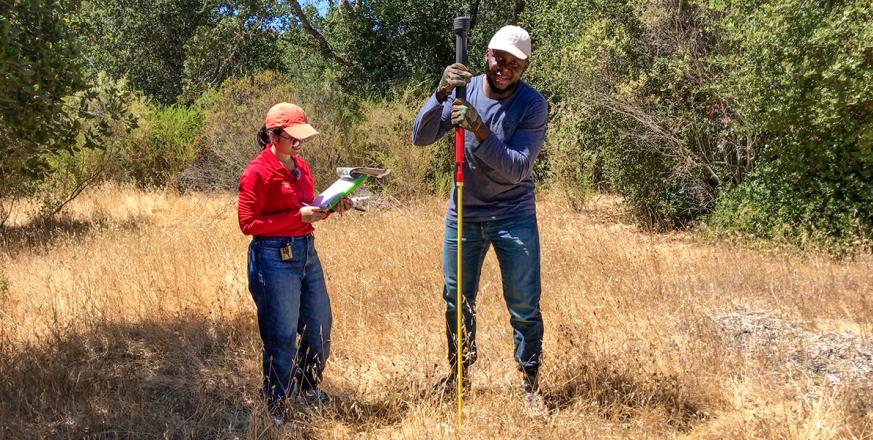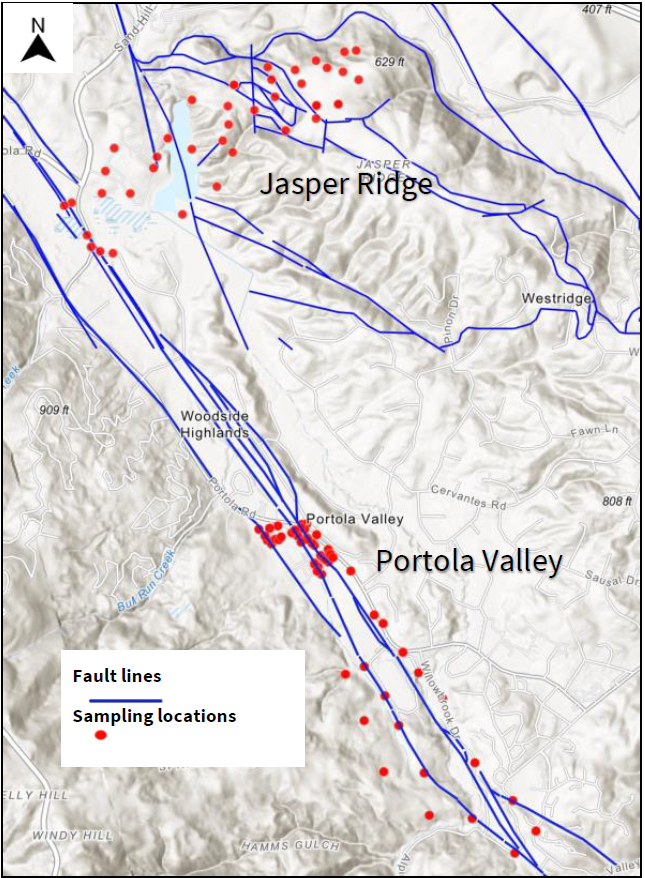Geologic hydrogen in western California

Summary
In the search for clean, renewable energy sources, one might not think to look within a biological preserve. However, JRBP’s serpentinite bedrock—the substrate that gives rise to serpentine wildflower displays—may help explain a major source of natural, clean-burning hydrogen. Serpentinization occurs when water combines with iron-rich rocks at high temperature and pressure, turning minerals such as olivine into serpentine. This process is also one of the main natural reactions that generate hydrogen.
 In 2022, this research project began surveying for hydrogen by taking soil gas samples along transects that span the preserve at right angles to the San Andreas Fault and cross many lesser faults, from the westernmost corner of JRBP to the northern tip. Sampling locations were also selected along the San Andreas Fault in Portola Valley. The gas-sampling device consists of a probe attached to a slide-hammer, which can quickly, with no digging, sample gases at one meter beneath the soil surface. The gas samples are analyzed for hydrogen, helium, carbon dioxide, light hydrocarbons, and fixed gas concentrations.
In 2022, this research project began surveying for hydrogen by taking soil gas samples along transects that span the preserve at right angles to the San Andreas Fault and cross many lesser faults, from the westernmost corner of JRBP to the northern tip. Sampling locations were also selected along the San Andreas Fault in Portola Valley. The gas-sampling device consists of a probe attached to a slide-hammer, which can quickly, with no digging, sample gases at one meter beneath the soil surface. The gas samples are analyzed for hydrogen, helium, carbon dioxide, light hydrocarbons, and fixed gas concentrations.
Results so far indicate that the hydrogen concentration in soil gases can be 30 to 35 times the atmospheric concentration. High hydrogen concentrations are mostly on or near faults, consistent with serpentinization together with tectonic activities that bring fresh mineral surfaces into contact with water. However, other explanations for the elevated hydrogen concentations have not been ruled out. Hydrogen concentrations are higher at Jasper Ridge than in Portola Valley. The image at right shows the sampling locations and faults (see Mathur et al. 2023, first link below). In the video below, Victor and Yashee sample soil gases.
Relative to natural gas, there are some disadvantages to hydrogen as an energy source, especially industrially produced hydrogen. However, the tables might turn if large natural sources of hydrogen can be identified and developed.
▶VIDEO: Victor Awosiji and Yashee Mathur sampling soil gases (3min)
Project Location (Sectors 12, 13, 14, 15, 20, 21, 22, 23, 29, 30, 31)
 |  |  |  |  |  |  |  |  |
 |  |  |  |  |  |  |  |  |
 |  |  |  |  |  |  |  |  |
 |  |  |  |  |  |  |  |  |
 |  |  |  |  |  |  |  |  |
 |  |  |  |  |  |  |  |  |



